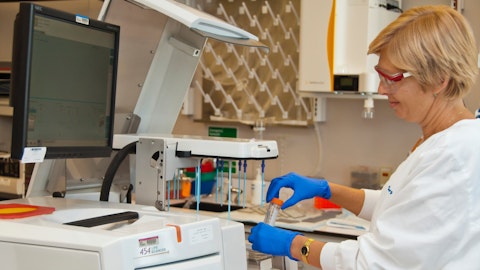Chubb Limited (NYSE:CB) Q3 2023 Earnings Call Transcript October 25, 2023
Operator: Ladies and gentlemen, thank you for standing by. My name is Brent, and I will be your conference operator today. At this time, I would like to welcome everyone to the Chubb Limited Third Quarter 2023 Earnings Call. All lines have been placed on mute to prevent any background noise. After the speakers’ remarks, there will be a question-and-answer session. [Operator Instructions] Thank you. It is now my pleasure to turn today’s call over to Ms. Karen Beyer, Senior Vice President and Director of Investor Relations. Ma’am, please go ahead.
Karen Beyer: Thank you, and welcome everyone to our September 30, 2023 third quarter earnings conference call. Our report today will contain forward-looking statements, including statements relating to company performance, pricing and business mix, growth opportunities, and economic and market conditions, which are subject to risk and uncertainties, and actual results may differ materially. Please see our recent SEC filings, earnings release, and financial supplement, which are available on our website at investors.com — investors.chubb.com for more information on factors that could affect these matters. We will also refer today to non-GAAP financial measures, reconciliations of which to the most direct comparable GAAP measures and related details are provided in our earnings press release and financial statement — supplement.

A woman in her car checking her insurance documents with a satisfied smile. Editorial photo for a financial news article. 8k. –ar 16:9
And now I’d like to introduce our speakers. First, we have Evan Greenberg, Chairman and Chief Executive Officer, followed by Peter Enns, our Chief Financial Officer. Then, we’ll take your questions. Also with us to assist with your questions today are several members of our management team. And now it’s my pleasure to turn the call over to Evan.
Evan Greenberg: Good morning. As you saw from the numbers, we had another outstanding quarter. Our performance was marked by double-digit global P&C premium growth, world-class P&C underwriting results, including an 88.4% combined ratio, record net investment income, and strong life operating income, all leading to record operating earnings per share. Once again, our premium revenue growth was well spread and broad-based, with excellent results in our commercial and consumer businesses in both our North American and international operations. Our annualized core operating ROE was 13.5%, with a return on tangible equity of 21.2%. Core operating income of $4.95 per share was up 58% over prior year. And for the first nine months, we have produced record operating income of $5.9 billion, or $14.27 per share, up 27.5%.
In the quarter, our underwriting performance was driven by a combination of strong earned premium growth, excellent underwriting margins, which included an ex-cat current accident year combined ratio of 84.3%, or 83% excluding agriculture, favorable prior period reserve development in both North America and Overseas General and relatively average cat losses compared to our expected. P&C underwriting income of $1.3 billion was up almost 84%. Our positive reserve development speaks to the strength of our reserves and our reasonably cautious or conservative approach to reserving. As I’ve said for years, we generally strive to recognize bad news early and are slow to recognize good news. We’re in a balance sheet business. Our loss reserves are the most important part of the liability side of our balance sheet.
On the asset side, record-adjusted net investment income of $1.4 billion was up $361 million, or 34% over prior year. Our portfolio yield was 4.1% at the end of the third quarter versus 3.4% a year ago, while our reinvestment rate is currently averaging 6.2%. We have very strong liquidity, and our investment income run rate will continue to grow as we reinvest our cash flow at higher rates. We are growing income without a change to our invested asset risk profile. In the quarter, we increased our ownership in Huatai Group to 69.6% and now we’re consolidating results, which were accretive to EPS and ROE. Earlier this month, we closed on additional shares and our ownership stands now at over 72%. I expect this to increase further and reach between 83% and 86%.
A summary of the financial impact of Huatai is provided for you in the earnings release and the financial supplement. Peter will have more to say about financial items, including cats, prior-period reserve development, investment income, book value, ROE and Huatai. Now, turning to growth, pricing and the rate environment. Consolidated net premiums for the company increased over 9% in the quarter, made up of 8.4% growth in our P&C business globally and about 15% in our Life division. Global P&C premium growth, which excludes agriculture, was 12.3%, with commercial lines up almost 10.5% and consumer lines up about 17.5%. In agriculture, crop premiums were lower than last year due to the timing of when we recognized them. Year-to-date premiums are in fact up modestly.
As to the higher combined ratio in agriculture this quarter, we simply recognized a quarter earlier than last year what we think is the likely development for the year based on what we know today about crop conditions and pricing. In terms of the commercial P&C rate environment, rates and price increases in property and casualty lines, in aggregate, remained strong in the quarter in both North America and our international divisions, while decreases in financial lines in North America continued. We remain vigilant and diligent about staying on top of loss cost inflation. Beginning with North America, commercial premiums, excluding agriculture, were up 8.7%. P&C growth was 10.5%, excluding financial lines, which were up 1%. Our very large middle market division had its best quarter of the year with premium growth of 16.3% and middle market financial lines up 1.5%.
Our major accounts and specialty division grew 7.2% with P&C up 8.4% and financial lines flat. Overall, pricing for total North America commercial increased 9.3%, including rate of 5.9% and exposure change that acts like rate of 3.2%. Let me provide a bit more color around rates and pricing. Pricing for commercial property and casualty was up 13.9%. Property pricing was up 23%, with rates up 16.6% and exposure change of 5.5%. Casualty pricing in North America was up 11%, with rates up 8.7% and exposure up 2%. In workers’ comp, which includes both primary comp and large account risk management, pricing was up 5.5%, with rates essentially flat and exposure up 6%. We are trending loss costs in North America at 6.7%, same as last quarter. And again, that compares to pricing of 9.3%.
In general, we’re trending loss costs in short tail classes at 5.8%. And long tail, excluding workers’ comp, loss costs are trending at 7.1%, and our first dollar workers’ comp book is trending at 4.7%. For financial lines, the underwriting environment remains aggressive, particularly in D&O. Rates have continued to decline. In the quarter, rates and pricing for North America financial lines, in aggregate, were down 4.8% and 3.8%, respectively. We’re trending financial lines loss costs at 4.7%. Renewal retention for our commercial businesses in North America was 92.7%, and our new business grew 14%. On the consumer side, our high-net-worth personal lines business had another excellent quarter, with premiums up over 9.5%, with strong retention and new business growth.
In our homeowners business, we achieved pricing of 15%, while our selected loss cost trend was similar to last quarter at 10.5%. Turning to our international general insurance operations. Net premiums were up about 21.5%, and this includes a 7.5% contribution to growth from the Huatai consolidation. Our international commercial business grew 17.5%, while consumer was up 28.4%. In our international retail business, growth was broad-based with all major regions producing double-digit growth. Latin America led the way this quarter with premiums up 23%, made up of commercial lines growth of 16% and consumer up more than 28%. Europe and Asia Pac had strong orders with growth of 14.2% and 10.2%, respectively. We continued to achieve improved rate to exposure across our international commercial portfolio, with pricing up 9.3%, rates up 5.7%, and exposure change of 3.4%.
Property and casualty lines, pricing was up 11.7%, with rates up 7.1% and exposure up 4.3%. While financial lines pricing was up 2.3%. Loss cost inflation across our international commercial portfolio remains steady from last quarter, trending at 6.6%. Within our international consumer, our A&H and personal lines divisions both had strong quarters, with premiums up 16.5% and over 40%, respectively. Personal lines growth in Latin America rebounded sharply with premiums up 43% on the back of growth in our Mexican auto portfolio where we’re taking significant rate actions to reflect the loss cost environment. In our international life business, which is almost entirely Asia, premiums were up nearly 20%, including the impact of the Huatai consolidation.
Life segment income was up nearly 15%, $288 million. In summary, we had a simply outstanding quarter, contributing to outstanding year-to-date results. We are growing exposure in a thoughtful and balanced way, mindful of risk environment and underwriting conditions, which are favorable in many areas of our business. Looking forward, we are confident in our ability to continue growing revenue and operating earnings globally, which in turn drive EPS through the three engines of P&C underwriting income, investment income, life income. I’m going to turn this call over to Peter, and then I’m going to come back and take your questions.
Peter Enns: Thank you, Evan, and good morning. First, I want to note that we completed our first quarter with Huatai Group as a consolidated subsidiary. The results of Huatai are reported at 100% within our financials, with only certain key metrics reported at the company’s 69.6% ownership interest, including consolidated core operating and net income, book and tangible book value, and ROE measures. Turning to our results, Chubb reached two milestones this quarter: invested assets reached $130 billion, and adjusted net investment income topped $1.4 billion. Operating cash flow was a record $4.7 billion, reflecting our record investment income and strong premium collections. During the quarter, Moody’s affirmed and moved our outlook from stable to positive.
And as you know, S&P affirmed our groups rating with stable outlook earlier this year. Core operating ROE on a deployed capital basis is approximately 15.5% and the related operating return on tangible equity is approximately 27%. Book value per share, excluding AOCI, increased 2.6% and 7% for the quarter and year-to-date, respectively, reflecting outstanding results for both periods. Tangible book value per share, excluding AOCI, decreased 4.2% for the quarter with 7.5 percentage points coming from the dilutive impact of consolidating Huatai. With the consolidation on July 1, Chubb had additional goodwill and intangibles of $3.5 billion pre-tax. In Q3, we already earned back almost two-thirds of that amount and expect to earn back the rest within this current fourth quarter.
Huatai had a modest impact on results this quarter in line with expectations, adding $0.12 or 2.5% to core operating income per share, third of which related to the favorable impact of purchase accounting adjustments in the quarter, which will decline over the next year. As previously noted, adjusted net investment income for the quarter was a record $1.415 billion or $140 million above the top end of our guidance, of which $100 million is related to Huatai, which was not included in our prior guidance. In the fourth quarter, we expect adjusted net investment income to be approximately $1.435 billion to $1.45 billion on a recurring basis, including Huatai, and to continue to grow from there. We remain consistent and conservative with our investments, with 83% of our fixed income portfolio rated investment-grade and an overall average credit rating of A.
This quarter, we recognized an unrealized loss on our portfolio of $2.2 billion after-tax, reflecting rising interest rates. We also recognized a modest favorable $18 million recovery of expected credit losses net of an immaterial impairment charge in the quarter, which attests to the overall quality of our portfolio. Huatai’s investment assets added $12.7 billion gross or $6.4 billion attributable to Chubb to our investment portfolio. With over two decades as a strategic partner with Huatai, we have deep insight into Huatai’s portfolio, and it fits well with our overall conservative approach to investing. 87% of Huatai’s investment portfolio is fixed income related, and is very high quality, with an average credit rating of A and with 98.5% rated investment-grade.
Turning to our underwriting business. For the quarter, we had pre-tax catastrophe losses of $670 million, principally from weather-related events and wildfires in North America. Total catastrophe losses were split: 82% U.S. and 18% internationally. Prior-period development in the quarter in our active businesses was a favorable $261 million pre-tax. The PPD in our active businesses this quarter consisted of $316 million favorable development in short-tail lines and $55 million of unfavorable development in long-tail lines. Our corporate run-off lines had adverse development of $61 million, principally related to environmental exposures. Our paid-to-incurred ratio for the quarter was 73% and was 84% through nine months. This quarter reflects the impact of strong premium growth on reserves and the timing of our crop insurance payments.
Our core operating effective income tax rate was 18.8% for the quarter, which is within our guided range of 18.5% to 19% for this year. I’ll now turn the call back over to Karen.
Karen Beyer: Thank you. At this point, we’re happy to take your questions.
See also 20 Least Egalitarian Countries in the World and 20 States with the Lowest Unemployment Rates.
Q&A Session
Follow Chubb Corp (Old Insider Filings) (NYSE:CB)
Follow Chubb Corp (Old Insider Filings) (NYSE:CB)
Operator: [Operator Instructions] Thank you. Your first question comes from the line of Bob Huang with Morgan Stanley. Your line is open.
Bob Huang: Good morning. Congratulations on the quarter. My first question is actually on reserving. You obviously talked about recognizing bad news first and good news later. Curious about your thoughts on the recent development. European reinsurers have talked more about the cautionary view on the U.S. casualty reserves. Social inflation has been around for years, but this is clearly something that European reinsures are talking more about now. Just given their recent renewed caution, so to speak, on the U.S. casualty side, are there any adverse trends that you’re seeing across the industry that would justify this view? Any specific factors that you would like to call out? Curious about your view on this. Thank you.
Evan Greenberg: Well, this is hardly a new topic, and I’m not going to really rehash old ground. We’ve been talking about this for a number of years. So, no, there’s nothing new. And just look back on our quarters, look back on what we use for loss cost development. Reinsurers who just simply — and we’ve been saying it, they’ve lagged in recognition. And so, they’re just beginning to catch up to it. Welcome [indiscernible]. I really don’t know what to add beyond that. There’s no news to us. And frankly, I don’t think there’s really that much news to them. They’ve just been slow to be willing to recognize it. And when you fall behind on casualty, it’s very painful. You got to catch up.
Bob Huang: Okay, got it. That’s actually very helpful. My second question is on cyber insurance. There has been a few very notable cyber breaches within consumer sector, casino, gaming, and more recently, a cybersecurity firm also had a pretty serious headline breach. Given Chubb is a industry leader in cyber insurance, curious — and also given that your recent partnership with SentinelOne, curious about your view on how the recent headline news could impact pricing environment as well as the industry as a whole? And then, how you think about Chubb positioning in cyber insurance going forward?
Evan Greenberg: Yeah, cyber is a relatively new line for the industry. It’s been around a number of years, but when you view it relative to other lines of business, it’s relatively new exposure. And by the way, it’s an evolving exposure. The world is more interconnected in everything today, for example, than it even was — more so than it was three years or five years ago. The world is a hostile environment, geopolitically and from a criminal element point of view. The ability to use cyber as a tool of mischief or worse and for ill-gotten gain is evolving. The tools that those actors use are evolving. At the same time, the industry, and Chubb included, are improving our ability to manage the risk and to underwrite and provide risk management capabilities around these exposures.
So, on one hand, the criminal element is gaining more tools. And at the same time, law enforcement and those like our industry are gaining better tools and better insight. It’s both. So, it’s evolving. It’s an active environment from a loss point of view, frequency and severity of loss. And industry pricing and industry coverage has to reflect that. I notice it in some segments of the business where I think there is discipline. And then, there are other segments of the business that I think could use more discipline. And the good news about crop, around crop cyber, unlike, say, casualty, it reveals its secrets quickly. And so, if you’re too loose in your underwriting and you’re just chasing the market share, you’re going to get caught pretty darn quick.
And I’ll stop right there.
Bob Huang: Thank you very much for that.
Operator: Your next question comes from the line of Greg Peters with Raymond James. Your line is open.
Greg Peters: All right. Good morning, everyone. Well, I assume it’s good morning, Evan, unless you’re in Singapore or in Europe.
Evan Greenberg: I’m right here in New York City.
Greg Peters: Well, awesome.
Evan Greenberg: Thank you, Greg. Good morning to you as well.
Greg Peters: Yeah. So, I was listening to your comments and you mentioned — you highlighted the Mexican auto business. You obviously highlighted the success of your North American personal lines business. It feels like we’re dealing with a once in a generation hard market in the auto insurance market. And I know you have a specialty business for your personal lines in North America, but I’m wondering if you have any thoughts of branching out into other areas of the market considering all of the dislocations that are occurring there?
Evan Greenberg: In general, personal lines market in North America, that’s not a market for us. We don’t bring anything to that party. And frankly, I think it is a well-served market. Some would suggest it’s over-served. We have a — not a — it’s pretty big niche, high net worth in the United States, and our capabilities and our insights are just so specially built for that, that we have a real true franchise advantage. We’re distinctive, and that’s what we look for. When you get outside the United States, general auto — general market auto and homeowners, it’s a commodity business, and most chase it for volume rather than for a decent return on underwriting. We’re very selective of how we do it. We constantly search and research environments around the world where it can suit our approach to underwriting and we can bring a distinct advantage to the marketplace and build a franchise of size that has a competitive advantage.
For a number of reasons, Mexico is one of those for us where we insure over 2 million autos, and we run a combined ratio that is the envy of the industry.
Greg Peters: Thanks for the color there. I guess, I’m going to pivot to this follow-up question on — back to the reinsurance business. I think I asked you about this in the previous quarter, but it’s just striking to me when I look at your global reinsurance business and I don’t see a lot of growth in the top-line. I know you are growing your property exposures, but where there’s a lot of rhetoric in the marketplace about where we are with the 1/1 renewals with pricing and reinsurance, I thought I’d ask you about your views on how you think pricing for reinsurance is going to evolve over the next year. If I look at your top-line results, it probably isn’t — probably don’t have a favorable view, but throw that out for you to comment on, please.
Evan Greenberg: Yeah. Greg, last year in the third quarter, so just the level set, there were, as you know, much larger cat events. And so, we collected a lot of reinstatement premium last year in the third quarter that we didn’t have those level of cat events this year. So, if you adjust for that, our reinsurance business actually grew in the third quarter by 20%. So, just to level set about that, we’re not running away from the reinsurance business. On the other hand, as I have said, I think it’s a, for Chubb, it is a better trade to us to grow our insurance property and catastrophe-related exposure than it is to do it through our insurance — our reinsurance operations. And so, we have put much more capital or taking more exposure on the insurance side where we’ve got great transparency, we’ve got great distribution reach, we’ve got underwriting expertise up and down the food chain from personalized to small commercial to large industrial commercial, the E&S, across North America, across the globe.



